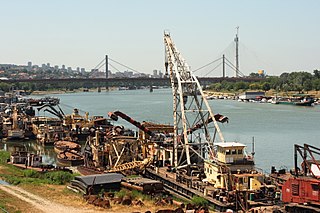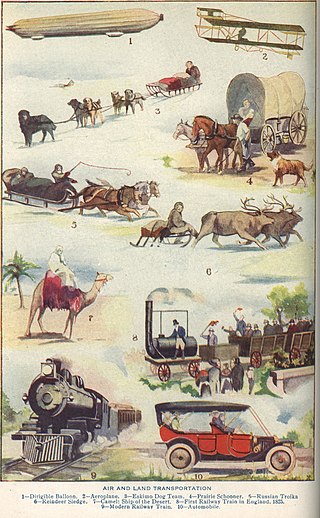
A boat is a watercraft of a large range of types and sizes, but generally smaller than a ship, which is distinguished by its larger size, shape, cargo or passenger capacity, or its ability to carry boats.

In macroeconomics, an industry is a branch of an economy that produces a closely related set of raw materials, goods, or services. For example, one might refer to the wood industry or to the insurance industry.

A kayak is a small, narrow human-powered watercraft typically propelled by means of a long, double-bladed paddle. The word kayak originates from the Greenlandic word qajaq.

The North American Industry Classification System or NAICS is a classification of business establishments by type of economic activity. It is used by governments and business in Canada, Mexico, and the United States of America. It has largely replaced the older Standard Industrial Classification (SIC) system, except in some government agencies, such as the U.S. Securities and Exchange Commission (SEC).
The Standard Industrial Classification (SIC) was a system for classifying industries by a four-digit code as a method of standardizing industry classification for statistical purposes across agencies. Established in the United States in 1937, it is used by government agencies to classify industry areas. Similar SIC systems are also used by agencies in other countries, e.g., by the United Kingdom's Companies House.

A watercraft or waterborne vessel is any vehicle designed for travel across or through water bodies, such as a boat, ship, hovercraft, submersible or submarine.

Sea-Doo is a Canadian brand of personal watercraft (PWC) and boats manufactured by Bombardier Recreational Products (BRP). All Sea-Doo models are driven by an impeller-driven waterjet. All Sea-Doo PWC models are produced at BRP's plants in Querétaro and Juárez, Mexico. Its Rotax engines are produced at BRP's plant in Gunskirchen, Austria. In 2016, Sea-Doo had a 45.8% share of the PWC market.

A riverboat is a watercraft designed for inland navigation on lakes, rivers, and artificial waterways. They are generally equipped and outfitted as work boats in one of the carrying trades, for freight or people transport, including luxury units constructed for entertainment enterprises, such as lake or harbour tour boats. As larger water craft, virtually all riverboats are especially designed and constructed, or alternatively, constructed with special-purpose features that optimize them as riverine or lake service craft, for instance, dredgers, survey boats, fisheries management craft, fireboats and law enforcement patrol craft.

Boating is the leisurely activity of travelling by boat, or the recreational use of a boat whether powerboats, sailboats, or man-powered vessels, focused on the travel itself, as well as sports activities, such as fishing or waterskiing. It is a popular activity, and there are millions of boaters worldwide.

A body of water, such as a river, canal or lake, is navigable if it is deep, wide and calm enough for a water vessel to pass safely. Such a navigable water is called a waterway, and is preferably with few obstructions against direct traverse that need avoiding, such as rocks, reefs or trees. Bridges built over waterways must have sufficient clearance. High flow speed may make a channel unnavigable due to risk of ship collisions. Waters may be unnavigable because of ice, particularly in winter or high-latitude regions. Navigability also depends on context: a small river may be navigable by smaller craft such as a motorboat or a kayak, but unnavigable by a larger freighter or cruise ship. Shallow rivers may be made navigable by the installation of locks that regulate flow and increase upstream water level, or by dredging that deepens parts of the stream bed.

Mode of transport is a term used to distinguish between different ways of transportation or transporting people or goods. The different modes of transport are air, water, and land transport, which includes rails or railways, road and off-road transport. Other modes of transport also exist, including pipelines, cable transport, and space transport. Human-powered transport and animal-powered transport are sometimes regarded as their own mode, but never fall into the other categories. In general, transportation is used for moving of people, animals, and other goods from one place to another. Means of transport, on the other hand, refers to the transport facilities used to carry people or cargo according to the chosen mode. Each mode of transport has a fundamentally different technological solution, and some require a separate environment. Each mode has its own infrastructure, vehicles, transport operators and operations.Transportations helps in the better utilisation of the resources of the backyard areas by linking them with the more advanced areas. It aids in the process of industrialisation and urbanization.
The Industry Classification Benchmark (ICB) is an industry classification taxonomy launched by Dow Jones and FTSE in 2005 and now used by FTSE International and STOXX. It is used to segregate markets into sectors within the macroeconomy. The ICB uses a system of 11 industries, partitioned into 20 supersectors, which are further divided into 45 sectors, which then contain 173 subsectors.

A canoe livery or canoe rental is a business engaged in the boat livery of canoes or kayaks. It is typically found on or near streams, rivers, or lakes that provide good recreational opportunities. A related but dissimilar business is a boat rental business, which is often distinguished by renting powered or sail craft and by not having a provision for return from a remote location. Such liveries can be found worldwide, wherever there are sufficient tourists or locals to support the activities.
A FIRE economy is any economy based primarily on the finance, insurance, and real estate sectors. Finance, insurance, and real estate are United States Census Bureau classifications. Barry Popik describes some early uses as far back as 1982. Since 2008, the term has been commonly used by Michael Hudson and Eric Janszen. It is New York City's largest industry and a prominent part of the service industry in the United States overall economy and other Western developed countries.
The number of personal watercraft-related accidents has increased with the popularity of personal watercraft (PWC) since their introduction during the late 1960s. The use of the term "jet ski" for all types of PWCs is a misnomer; Jet Ski is a registered trademark in the United States for a line of PWCs manufactured by Kawasaki). With the increased use of personal watercraft since their inception, the hazards accompanying their use have also increased. According to U.S. government reports, most accidents are associated with rental operators, underage operators, under-trained and undereducated boaters and a variety of factors associated with recreational-boating accidents. Due to their affordability, ease of use, and relatively low transportation and maintenance costs, personal watercraft have significantly increased the number of water-based enthusiasts in the U.S. This rise in participation has created conflicts between the various boating segments in the U.S. and a need for additional boater education. Recreational-boating accidents are the second-largest transportation-related cause of injury in the U.S..
The economy of the United States is divided into economic sectors. The North American Industry Classification System (NAICS) was developed in 1997 and is used by the United States Census Bureau and U.S. Securities Exchange Commission (SEC).

The Blue River is a 57-mile-long (92 km), two-forked stream that runs through Harrison, Crawford and Washington counties in Indiana. The headwaters of the North Fork arise near Salem in Washington County and flow south, and the headwaters of the South Fork arise near New Liberty and flow southwest. The two small forks converge in Fredericksburg. From the confluence, the river flows south until it joins Ohio River in the Harrison-Crawford State Forest, just upstream from Leavenworth.
The United States Economic Census is the U.S. federal government's official five-year measure of American business and the economy. It is conducted by the U.S. Census Bureau, and response is required by law. Forms go out to nearly 4 million businesses, including large, medium and small companies representing all U.S. locations and industries. Respondents are asked to provide a range of operational and performance data for their companies. Trade associations, chambers of commerce, and businesses use information from the economic census for economic development, business decisions, and strategic planning purposes. The last Economic Census was conducted for the year ending December 2017.
The Recreational Craft Directive, Directive 2013/53/EU, originally Directive 94/25/EC on recreational craft amended by Directive 2003/44/EC, is a European Union directive which sets out minimum technical, safety and environmental standards for boats, personal watercraft, marine engines and components in Europe. It covers boats between 2.5 and 24m, personal watercraft, engines and a number of components built since 1998. It ensures their suitability for sale and use in Europe.
Boat building has been a part of the history of Ontario, Canada for thousands of years. From the hand-crafted birch bark canoes of the indigenous people to modern factory-built speedboats, the construction of small boats for fishing, transportation and later water sports has been a widespread commercial activity in the province.














